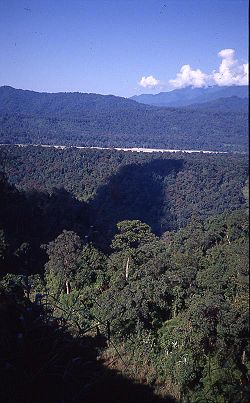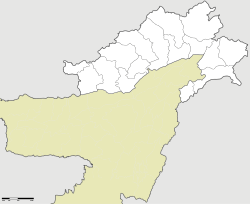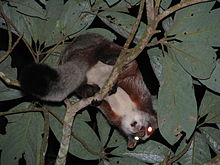- Namdapha National Park
-
Namdapha National Park — national park — IUCN Category II (National Park)Canopy cover of Namdapha National Park Coordinates 27°29′N 96°23′E / 27.483°N 96.383°ECoordinates: 27°29′N 96°23′E / 27.483°N 96.383°E Country India State Arunachal Pradesh District(s) Changlang Established 1974 Nearest city Miao Time zone IST (UTC+05:30) Area 1,985.23 square kilometres (766.50 sq mi) Climate
Temperature
• Summer
• Winter
• 20 °C (68 °F)
• 30 °C (86 °F)Governing body Government of Arunachal Pradesh Website arunachalforests.gov.in/Namdapha%20Tiger%20Reserve.html Namdapha National Park is the largest protected area in the Eastern Himalaya biodiversity hotspot and is located in Arunachal Pradesh in Northeast India. It is also the largest national park in India in terms of area. It is located in the Eastern Himalayan sub-region and is recognized as one of the richest areas in biodiversity in India.[1] The park harbours the northernmost lowland evergreen rainforests in the world at 27°N latitude.[2] The area is also known for extensive Dipterocarp forests.[3]
Contents
Geography
The park is located in Changlang district of the Northeastern state of Arunachal Pradesh, near its border with Myanmar. It spans an area of 1985 km2 with 177 km2 in buffer zone and 1808 km2 in the core area. The park is located between the Dapha bum range of the Mishmi Hills and the Patkai range with a wide altitudinal range between 200 m asl and 4571 m asl.[1][3] The area falls under both the Palearctic and Indo Malayan biogeographic areas resulting in a diverse species assemblage. The habitat changes with increasing altitude from sub-tropical broadleaved forests to subtropical pine forests, temperate broadleaved forests and at the higher elevations, to alpine meadows and perennial snow. The park has extensive bamboo and secondary forests in addition to the primary forests.
Flora
Sapria himalayana and Balanophora are root parasites related to Rafflesia recorded from the area.[4] The floristic diversity of Namdapha is as follows:
Floristic Composition of Namdapha National Park[5] Category (total no.) Dicots Monocots Lichens Bryophytes Pteridophytes Gymnosperms Families (215) 119 (55.35) 19 (8.84) 17 (7.90) 21 (9.77) 36 (16.74) 3 (1.4) Genera (639) 403 (63) 111 (17.37) 34 (5.32) 33 (5.16) 54 (8.45) 4 (0.63) Species (1119) 674 (60.25) 196 (17.5) 73 (6.53) 59 (5.27) 112 (10) 5 (0.45) Values in parentheses are percentage of total number.
Fauna
Mammals
Because of many different vegetation zones, the park is home to a great diversity of mammal species. Four big cat species occurre in the park: snow leopards, clouded leopards, common leopards and tigers. Other large predators are dholes, wolves, and Asiatic black bears. Smaller carnivores include red panda, red fox, yellow-throated marten, Eurasian otter, Oriental small-clawed otter, spotted linsang, binturong, common palm civet, small indian civet, large indian civet, masked palm civet, marbled cat, fishing cat, Asiatic golden cat, and two species of mongoose. Large herbivores are represented by elephants wild boar, forest musk deer, indian muntjac, hog deer, sambar, gaur, common goral, mainland serow, takin and bharal.[6] Seven species of non-human primates including Stump-tailed macaque and Slow Loris, Hoolock Gibbons, Capped Langurs, Assamese Macaques and Rhesus Macaques.[7][8]
Birds
Among the earlier papers on the birds of Namdapha was published in 1990.[9] The park has about 425 bird species with many more to be recorded from work in the higher areas.[3] There are five species of Hornbills recorded from the area. Several species of rare wren-babblers have been recorded in Namdapha. Other bird groups include laughing thrushes, parrotbills, fulvettas, shrike babblers and scimitar babblers. The Snowythroated Babbler is a rare species of Babbler found only in the Patkai and Mishmi hills and nearby areas in Northern Myanmar, is found in Namdapha. Other rare, restricted range or globally endangered species include the Rufous-necked Hornbill, Green Cochoa, Purple Cochoa, Beautiful Nuthatch, Ward's Trogon, Ruddy Kingfisher, Blue-eared Kingfisher, Whitetailed fish eagle, Eurasian Hobby, Pied Falconet, White-winged Wood Duck, Himalayan Wood-owl, Rufous-throated Hill-partridge, and Whitecheeked hill partridge. Several leaf warblers and migrants such as Amur Falcon and several Thrushes can be seen here.[3] The first mid-winter waterfowl census in Namdapha was conducted in 1994 when species such as the White-bellied Heron, a Critically Endangared bird was recorded for the first time.[10]
Ethnography
There are a few settlements of Lisu tribal people within the park. Most of the Lisus are, however, located beyond the eastern border of the park towards the international border of India with Myanmar. There are also Chakma, Tangsa and Singpho settlements around the park.
References
- ^ a b Deb, P & Sundriyal, RC. (2007) Tree species gap phase performance in the buffer zone area of Namdapha National Park, Eastern Himalaya, India. Tropical Ecology 48(2): 209-225 PDF
- ^ Proctor, J., K. Haridasan & G.W. Smith. (1998) How Far North does Lowland Evergreen Tropical Rain Forest Go? Global Ecology and Biogeography Letters,7(2). pp. 141-146
- ^ a b c d Datta, A., Naniwadekar, R. & Anand, M.O. 2008. Hornbills, hoolocks and hog badgers: Long‐term monitoring of threatened wildlife with local communities in Arunachal Pradesh, north‐east India. Final report to the Rufford Small Grants Program (UK). Nature Conservation Foundation, Mysore, India. 80 pp. PDF
- ^ Arunachalam A, Sarmah R, Adhikari D, Majumder M, & Khan ML. (2004) Anthropogenic threats and biodiversity conservation in Namdapha nature reserve in the Indian Eastern Himalayas. Current Science87(4). p.447. PDF
- ^ Chauhan AS, Singh KP, Singh DK. (1996) A contribution to the Flora of Namdapha Arunachal Pradesh. Kolkata: Botanical Survey of India 422p
- ^ Choudhury, A.U. (2003). The mammals of Arunachal Pradesh. Regency Publications, New Delhi. 140pp
- ^ Choudhury, A.U. (1995). The primates of Namdapha National Park. IPPL News 22(2): 23-24.
- ^ Chetry D, Medhi R, Biswas J, Das D & Bhattacharjee PC. (2003) Nonhuman Primates in the Namdapha National Park, Arunachal Pradesh, India. International Journal of Primatology 24(2). p. 383-388. DOI 10.1023/A:1023057401967 LINK
- ^ Choudhury, A.U. (1990). Bird observations from Namdapha National Park and adjacent areas. Arunachal Forest News 8 (1&2): 38-43. Itanagar.
- ^ Choudhury, A.U. (1996). Winter waterfowl count in Namdapha National Park. OBC Bulletin 23:29-30.
External links
- Official Website of Namdapha National Park
- Website of Namdapha created by the Nature Conservation Foundation
• Part of the series on National Parks of India •

Andaman &
Nicobar IslandsAndhra Pradesh Arunachal Pradesh Mouling • NamdaphaAssam Bihar Valmiki• Kanwar Taal Bird Sanctuary • Vikramshila Dolphin SanctuaryChhattisgarh Goa Gujarat Haryana Himachal Pradesh Jammu & Kashmir Jharkhand Karnataka Kerala Madhya Pradesh Maharashtra Manipur Meghalaya Mizoram Nagaland Orissa Rajasthan Sikkim Tamil Nadu Uttar Pradesh Uttarakhand West Bengal Tiger Reserves of India Assam Kaziranga Tiger Reserve · Manas Tiger Reserve · Nameri Tiger ReserveArunachal Pradesh Namdapha Tiger Reserve · Pakhui Tiger ReserveAndhra Pradesh Bihar Valmiki Tiger ReserveChhattisgarh Jharkhand Palamau Tiger ReserveKarnataka Bandipur Tiger Reserve · Nagarhole (extension) Tiger Reserve · Bhadra Tiger Reserve · Dandeli-AnashiTiger Reserve ·
Bannerghatta tiger and lion reserve · Biligiri Rangaswamy Temple Wildlife Sanctuary · Kudremukh Tiger ReserveKerala Periyar Tiger Reserve · Parambikulam Tiger ReserveMadhya Pradesh Bandhavgarh Tiger Reserve · Bori-Satpura Tiger Reserve · Kanha Tiger Reserve · Panna Tiger Reserve · Pench Tiger Reserve · Ratapani Tiger Reserve · Sanjay Dubri Tiger ReserveMaharashtra Melghat Tiger Reserve · Pench Tiger Reserve · Tadoba-Andhari Tiger Reserve · Shahayadri Tiger reserve · Nagzira-Navegaon Tiger Reserve · Bhor Tiger ReserveMizoram Orissa Rajasthan Tamil Nadu Kalakkad Mundanthurai Tiger Reserve · Anamalai Tiger Reserve · Mudumalai Tiger Reserve · Sathyamangalam Tiger ReserveUttar Pradesh Uttarakhand Corbett Tiger ReserveWest Bengal Buxa Tiger Reserve · Sunderbans Tiger ReserveCategories:- IUCN Category II
- Tiger reserves of India
- National parks of India
- Changlang
- Tourism in Arunachal Pradesh
- Protected areas established in 1974
Wikimedia Foundation. 2010.





